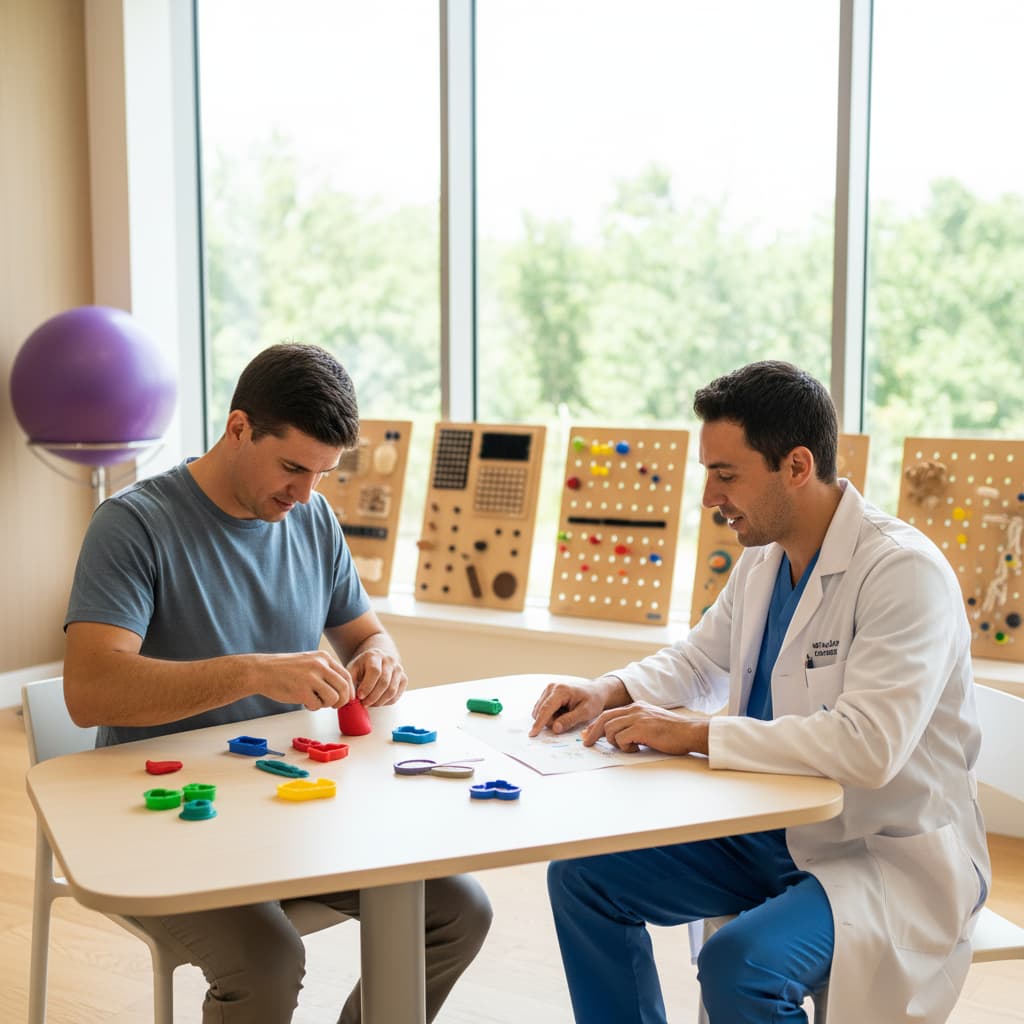034-33126601-5

Occupational therapy in psychiatry

What is Occupational Therapy in Psychiatry?
Occupational Therapy in psychiatry is a branch of rehabilitation sciences that helps individuals with mental disorders to acquire or regain the skills necessary for an independent, productive, and satisfying life.
The Core Philosophy: The belief that “occupation,” meaning engagement in purposeful and meaningful activities, is essential for human health and well-being. Here, “occupation” refers not just to a job or profession, but to all activities that fill our time:
Self-Care: Daily activities such as bathing, dressing, eating, and managing medications.
Productivity: Work, education, volunteering, and home management.
Leisure: Hobbies, sports, social activities, and recreation.
A mental disorder can disrupt an individual’s ability to perform in one or all of these areas. The Occupational Therapist (OT) helps the client overcome these barriers.
Who Needs Occupational Therapy in Mental Health?
Occupational Therapy is beneficial for a wide range of individuals with psychiatric disorders, including:
Mood Disorders: Major Depressive Disorder, Bipolar Disorder.
Anxiety Disorders: Generalized Anxiety Disorder (GAD), Panic Disorder, Social Phobias.
Psychotic Disorders: Schizophrenia and related disorders.
Post-Traumatic Stress Disorder (PTSD).
Personality Disorders: Such as Borderline Personality Disorder (BPD).
Eating Disorders: Anorexia Nervosa, Bulimia Nervosa.
Substance Use Disorders.
Neurodevelopmental Disorders: Such as Autism Spectrum Disorder (ASD) and Attention-Deficit/Hyperactivity Disorder (ADHD) in adults.
Approaches and Therapeutic Techniques in Mental Health OT
An OT uses a “client-centered” approach, meaning the treatment plan is designed based on the unique goals, values, and needs of each individual. Here is one of the most important and comprehensive approaches:
The Psychosocial Rehabilitation Model
This model is a comprehensive therapeutic framework that aims not only to reduce the symptoms of the illness but also to enhance the individual’s overall functioning in the community. Within this model, the OT focuses on practical life skills.
Key Components of This Therapeutic Approach:
1. Activities of Daily Living (ADL) Skills Training:
Goal: To help the individual achieve independence in basic tasks.
Examples:
Personal Hygiene Management: Establishing a regular routine for bathing and grooming (which can be impaired in severe depression).
Medication Management: Teaching methods for remembering to take medications, understanding side effects, and the importance of treatment adherence.
Meal Planning and Preparation: Teaching skills for shopping, budgeting, and cooking simple, healthy meals.
2. Social Skills Development:
Goal: To improve the individual’s ability to communicate effectively and build healthy relationships.
Examples:
Group Therapy: Conducting group sessions on topics like initiating conversations, active listening, assertiveness, and conflict resolution.
Role-Playing: Practicing challenging social situations (like a job interview or asking for help) in a safe environment.
3. Time Management & Daily Structuring:
Goal: To help individuals (especially those with depression or schizophrenia who may have lost their motivation and daily structure) create a balanced daily schedule.
Examples:
Creating a Weekly Timetable: Planning for self-care, productivity, and leisure activities.
Energy Conservation Techniques: Teaching how to break down large tasks into smaller steps to prevent fatigue and feelings of failure (e.g., for individuals with depression).
4. Pre-Vocational Skills & Re-integration into Work/Education:
Goal: To prepare the individual to enter or return to the workforce or educational settings.
Examples:
Interest and Aptitude Assessment: Helping the individual identify jobs that match their skills and limitations.
Job Skills Training: Resume writing, interview practice, learning how to interact with colleagues and supervisors.
Sheltered Workshops: Providing a supportive work environment to practice skills before entering the competitive job market.
5. Stress Management & Coping Strategies:
Goal: To equip the individual with tools to manage symptoms and daily stressors.
Examples:
Teaching Relaxation Techniques: Deep breathing, progressive muscle relaxation.
Expressive Activities: Using art, music, writing, or gardening as a way to process emotions and reduce anxiety.
Problem-Solving Training: Helping the individual identify problems, brainstorm possible solutions, and choose the best option.
6. Exploring and Engaging in Meaningful Leisure Activities:
Goal: To help the individual find hobbies and activities that are enjoyable and meaningful to them, thereby strengthening their sense of identity and purpose.
Example: Taking the client to a library, a sports class, or a local art group to discover new interests.
Settings for Mental Health Occupational Therapy Services
Occupational Therapists work in a variety of settings:
Psychiatric Hospitals (Inpatient)
Mental Health Clinics (Outpatient)
Community-Based Day Programs
Addiction Rehabilitation Centers
Prisons and Correctional Facilities
In the client’s home (Home Visits)